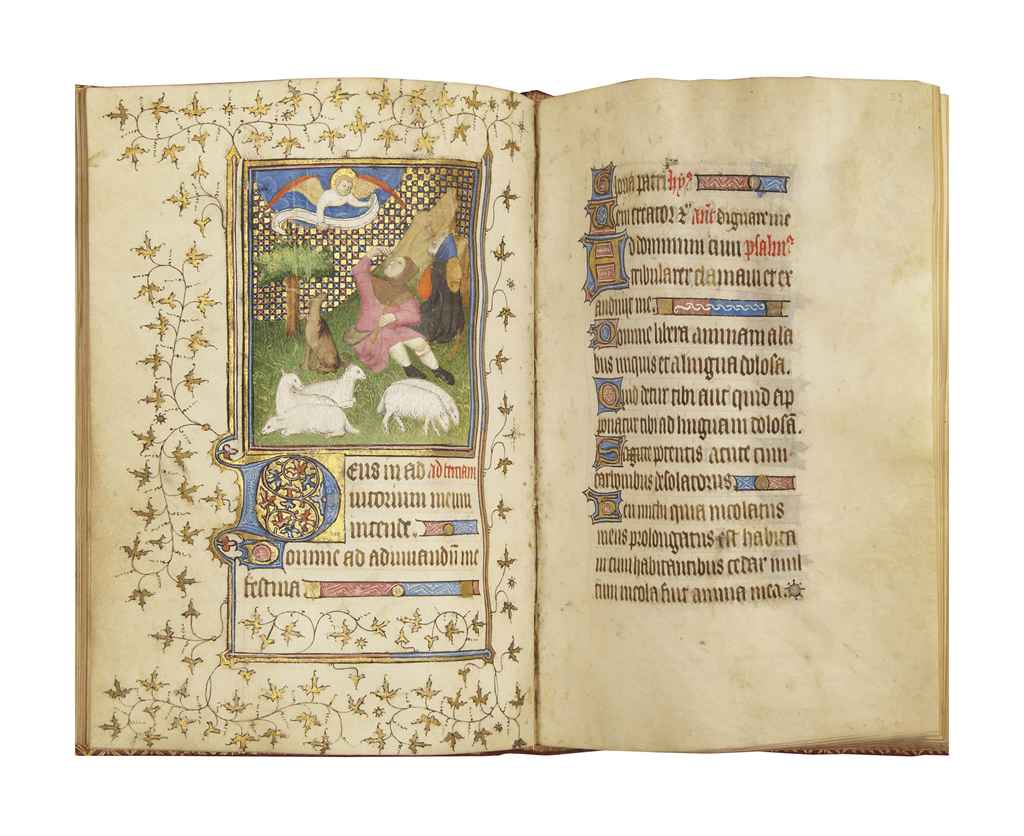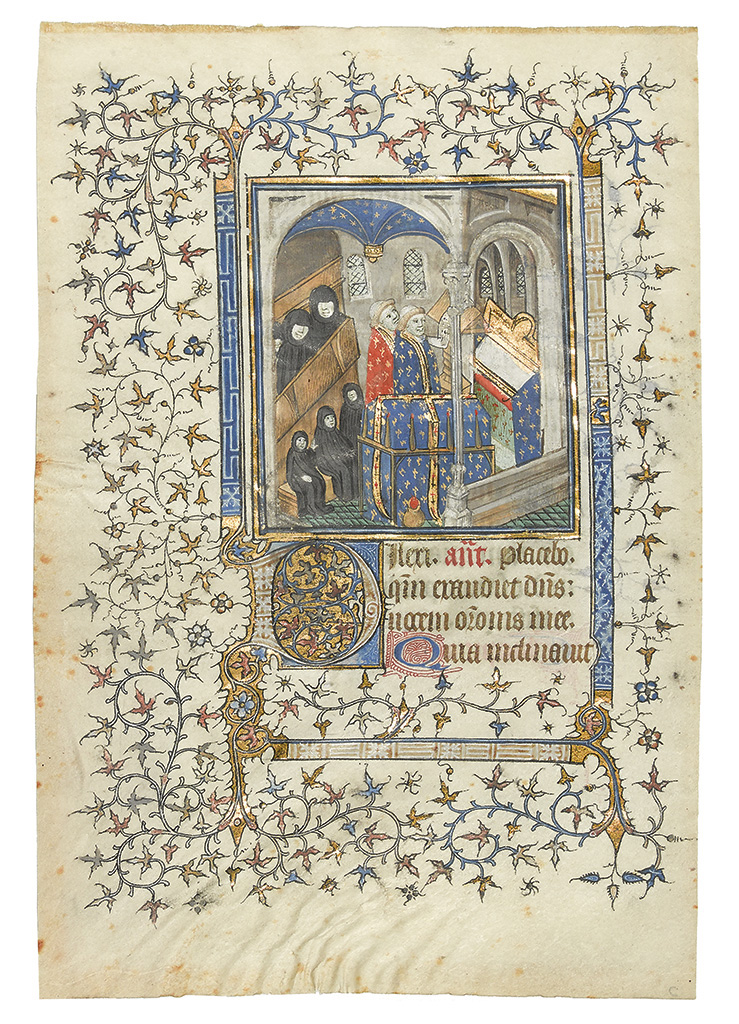Workshop of the Boucicaut Master. The Nativity. MINIATURE ON A LEAF FROM A MANUSCRIPT BOOK OF HOURS ON VELLUM. [Paris, 1408]. 174 x 130mm. (6 7/8 x 5in.), the miniature 60 x 63mm. (2 3/8 x 2 1/2in.) in colors and liquid and burnished gold, showing Mary in a blue robe reclining on a red and gold cushion under a thatched roof, behind her the child swaddled lying in a pink manger watched over by the ox and the ass, Joseph seated by a cooking pot on a fire, grassy foreground with flowers, diapered background; the miniature above five lines of text in brown ink in a carefully executed gothic textura script, with one large and two small initials and two line fillers in colors and burnished gold; full border consisting of three-sided baguette in burnished gold with colored scrollwork and scrolling ivy stems with leaves in burnished gold, blue, orange and white; verso with fifteen lines of text, two large initials and two line fillers in colors and burnished gold, rubric in red, and a full border of ivy vines and leaves; some flaking of gold and colors, some darkening within vine-stem border, faint damp-staining to margin and border not affecting text or miniature, matted and framed. This charming Nativity scene, illustrating the office of Prime of the Hours of the Virgin, comes from one of very few Books of Hours whose production can be precisely dated and localized. The volume of which it formed a part was signed by its scribe Factum est anno m cccc viii quo ceciderunt pontes parisiis , "Completed in the year 1408 when the bridges fell in Paris," a reference to the events of January 29-31, 1408, when the Petit Pont, the Grand Pont, and the Pont Neuf were carried away by floods (J.A. Delaure, Histoire physique, civile et morale de Paris , III, Paris, 1863, p. 342). A similar Book of Hours in the Bodleian Library, Douce 144, bears a similar inscription, dated (Old Style) 1407 (Andrew G. Watson, Catalogue of Dated and Datable Manuscripts...in Oxford Libraries, Oxford, 1984, no. 462 and pl. 256; Otto Pächt and J.J.G. Alexander, Illuminated Manuscripts in the Bodleian Library Oxford , I, Oxford, 1966, no. 641 and pl. XLIX-L; Millard Meiss, French Painting in the Time of Jean de Berry: The Boucicaut Master , London, 1968, pp. 106-108 and fig. 49-60). Both manuscripts were written by the same scribe, and both include miniatures from the workshop of the Boucicaut Master, a Parisian atelier that is credited with illuminating more than thirty Books of Hours between 1405 and 1420 (Christopher de Hamel, A History of Illuminated Manuscripts , Boston, 1986, pp. 172-173). The codex which contained this miniature belonged in the mid-nineteenth century to the London jeweler and collector John Boykett Jarman. Together with other manuscripts in his possession it was damaged in a storm-induced flood of his house in Grosvenors Street in August 1846 (Janet Backhouse, "A Victorian Connoisseur and His Manuscripts, British Museum Quarterly , 32, 1967, pp. 76-92). It was on this occasion that the Nativity leaf acquired the damp stains that are still faintly visible around its edges. When Jarman's effects were sold after his death in 1864, the book was bought by Edward Arnold of The Grove, Dorking. After Arnold's sale in 1929, the manuscript was purchased by Sir Alfred Chester Beatty, who disposed of a number of miniatures during 1930-1932 and designated the remainder of the volume his W. MS. 103. When the book was sold again, with other Chester Beatty Western Manuscripts, eleven of the finest miniatures, including the Nativity, were sold separately (Sotheby's London, 24 June 1969, lots 58, and 58 A-K). A history of the manuscript and a census of its dispersed leaves with their present locations, has been provided by Margaret M. Manion, Vera F. Vines and Christopher de Hamel, Medieval and Renaissance Manuscripts in New Zealand Collections , Melbourne, 1989, no. 80 (see also Sotheby's London, 21 June 1988, lot 13 [the miniature of St. Martin from the same m
Workshop of the Boucicaut Master. The Nativity. MINIATURE ON A LEAF FROM A MANUSCRIPT BOOK OF HOURS ON VELLUM. [Paris, 1408]. 174 x 130mm. (6 7/8 x 5in.), the miniature 60 x 63mm. (2 3/8 x 2 1/2in.) in colors and liquid and burnished gold, showing Mary in a blue robe reclining on a red and gold cushion under a thatched roof, behind her the child swaddled lying in a pink manger watched over by the ox and the ass, Joseph seated by a cooking pot on a fire, grassy foreground with flowers, diapered background; the miniature above five lines of text in brown ink in a carefully executed gothic textura script, with one large and two small initials and two line fillers in colors and burnished gold; full border consisting of three-sided baguette in burnished gold with colored scrollwork and scrolling ivy stems with leaves in burnished gold, blue, orange and white; verso with fifteen lines of text, two large initials and two line fillers in colors and burnished gold, rubric in red, and a full border of ivy vines and leaves; some flaking of gold and colors, some darkening within vine-stem border, faint damp-staining to margin and border not affecting text or miniature, matted and framed. This charming Nativity scene, illustrating the office of Prime of the Hours of the Virgin, comes from one of very few Books of Hours whose production can be precisely dated and localized. The volume of which it formed a part was signed by its scribe Factum est anno m cccc viii quo ceciderunt pontes parisiis , "Completed in the year 1408 when the bridges fell in Paris," a reference to the events of January 29-31, 1408, when the Petit Pont, the Grand Pont, and the Pont Neuf were carried away by floods (J.A. Delaure, Histoire physique, civile et morale de Paris , III, Paris, 1863, p. 342). A similar Book of Hours in the Bodleian Library, Douce 144, bears a similar inscription, dated (Old Style) 1407 (Andrew G. Watson, Catalogue of Dated and Datable Manuscripts...in Oxford Libraries, Oxford, 1984, no. 462 and pl. 256; Otto Pächt and J.J.G. Alexander, Illuminated Manuscripts in the Bodleian Library Oxford , I, Oxford, 1966, no. 641 and pl. XLIX-L; Millard Meiss, French Painting in the Time of Jean de Berry: The Boucicaut Master , London, 1968, pp. 106-108 and fig. 49-60). Both manuscripts were written by the same scribe, and both include miniatures from the workshop of the Boucicaut Master, a Parisian atelier that is credited with illuminating more than thirty Books of Hours between 1405 and 1420 (Christopher de Hamel, A History of Illuminated Manuscripts , Boston, 1986, pp. 172-173). The codex which contained this miniature belonged in the mid-nineteenth century to the London jeweler and collector John Boykett Jarman. Together with other manuscripts in his possession it was damaged in a storm-induced flood of his house in Grosvenors Street in August 1846 (Janet Backhouse, "A Victorian Connoisseur and His Manuscripts, British Museum Quarterly , 32, 1967, pp. 76-92). It was on this occasion that the Nativity leaf acquired the damp stains that are still faintly visible around its edges. When Jarman's effects were sold after his death in 1864, the book was bought by Edward Arnold of The Grove, Dorking. After Arnold's sale in 1929, the manuscript was purchased by Sir Alfred Chester Beatty, who disposed of a number of miniatures during 1930-1932 and designated the remainder of the volume his W. MS. 103. When the book was sold again, with other Chester Beatty Western Manuscripts, eleven of the finest miniatures, including the Nativity, were sold separately (Sotheby's London, 24 June 1969, lots 58, and 58 A-K). A history of the manuscript and a census of its dispersed leaves with their present locations, has been provided by Margaret M. Manion, Vera F. Vines and Christopher de Hamel, Medieval and Renaissance Manuscripts in New Zealand Collections , Melbourne, 1989, no. 80 (see also Sotheby's London, 21 June 1988, lot 13 [the miniature of St. Martin from the same m
.jpg)
.jpg)
.jpg)
.jpg)


.jpg)




Testen Sie LotSearch und seine Premium-Features 7 Tage - ohne Kosten!
Lassen Sie sich automatisch über neue Objekte in kommenden Auktionen benachrichtigen.
Suchauftrag anlegen